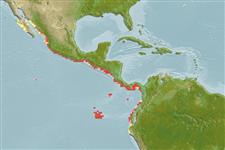Common names from other countries
Environment: milieu / climate zone / depth range / distribution range
Ecologie
; diepteverspreiding 0 - 40 m (Ref. 4). Tropical, preferred 27°C (Ref. 107945); 28°N - 6°S, 115°W - 77°W (Ref. 112659)
Eastern Pacific: From Baja California Sur to the west coast of Peru and the Galapagos Islands.
Length at first maturity / Size / Gewicht / Leeftijd
Maturity: Lm ?, range 4 - ? cm Max length : 32.0 cm TL mannelijk/geslacht niet bekend; (Ref. 4); 30 cm TL (female)
It has lengths of 32 cm (male) and 30 cm (female), maximum total body length; 1 to 13 cm (male) and 1 to 12 cm (female), carapace length (Ref. 4). Maximum depth from Ref. 112672. Occurs at depths from 0 to 18 m and it inhabits shallow coastal waters among rocks and in cracks and crevices. The animals are nocturnal (Ref. 4). Feeds mainly on mollusks, crustaceans and organic matter (Ref. 112086).
Life cycle and mating behavior
Geslachtsrijpheid | Voortplanting | Kuitschieten | Eieren | Fecundity | Larven
Members of the order Decapoda are mostly gonochoric. Mating behavior: Precopulatory courtship ritual is common (through olfactory and tactile cues); usually indirect sperm transfer.
Holthuis, L.B. 1991. (Ref. 4)
Status op de Rode Lijst van het IUCN (Ref. 130435)
Status bij CITES (Ref. 108899)
Not Evaluated
Not Evaluated
Gebruik door de mens
Visserij: commercieel
FAO - Visserij: landings | FIRMS (Stock assessments) | FishSource | Sea Around Us
Tools
Internet-bronnen
Estimates based on models
Preferred temperature
(Ref.
115969): 22.7 - 29.1, mean 27 (based on 170 cells).
Weerstandsvermogen
Hoog, minimale populatieverdubbelingstijd minder dan 15 maanden (K=0.38-0.45).
Kwetsbaarheid
Low vulnerability (22 of 100).
